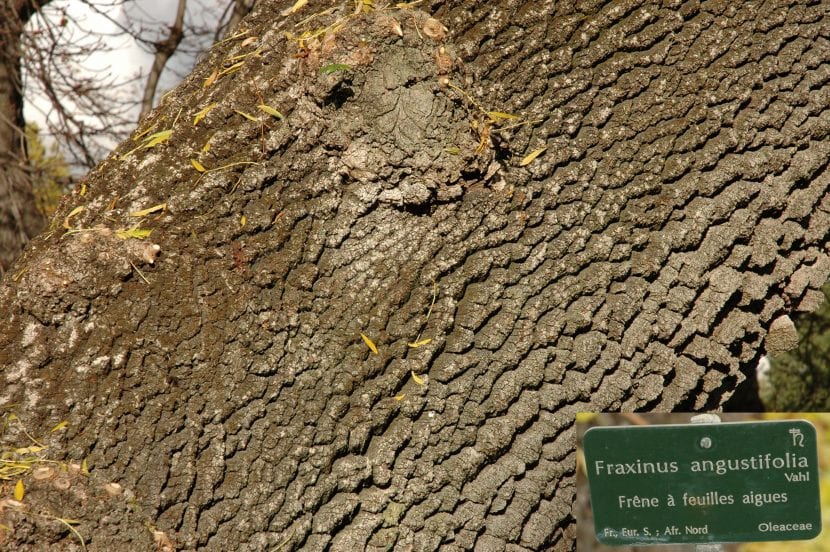
Image - Wikimedia / Arielinson
The tree whose scientific name is Fraxinus angustifolia It is a fast-growing plant that, having a wide and densely branched crown, provides excellent shade during spring and summer, and in winter it remains highly ornamental even if it runs out of leaves 😉.
Its maintenance is not complicated at all, although yes, it will need to be in a large garden so that its roots can spread as long as they need without causing damage. Let's get to know it better.
Origin and characteristics

Image - Wikimedia / Giovanni Caudullo
Our protagonist it is a deciduous tree whose scientific name is Fraxinus angustifolia, and is popularly known as common ash, narrow-leaved ash, wild ash, lupias, or fragino. It grows wild in the regions painted in green on the map, that is, in Spain its habitat is found in the Iberian Peninsula and the Balearic Islands, and we also have it in North Africa, a large part of France, Italy, Greece and other points from the south and southeast of both Europe and Asia.
Es typical of riverside forests, where it usually grows with other trees, such as poplars, the willows, the oaks, elm trees or poplars.
It is characterized by reaching a height that, in suitable conditions, reaches 25 meters in height. The crown, as we said, is wide, about 5-6 meters in diameter, formed by opposite, odd-pinnate leaves, with 7 to 9 leaflets that are ovate-lanceolate, the upper surface green and glabrous, and the underside pubescent.
Flowers emerge in spring, and they are grouped in dense, terminal and axillary panicles. The fruit is a linear-lanceolate samara, in whose interior the seeds that are provided with a wing mature, which, with the help of the wind, can move away from the mother plants.
Subspecies
There are 4:
- Fraxinus angustifolia subsp. angustifolia: it is native to western Europe to northern France, and northwestern Africa.
- Fraxinus angustifolia subsp. oxycarp: known as the Caucasian ash, native to eastern Europe to the Czech Republic, and from southwestern Asia to northern Iran.
- Fraxinus angustifolia subsp. Syriac: native to the Middle East and West Asia.
- Fraxinus angustifolia subsp. danubialis: native of central Europe.
What are their cares?
If you want to have a copy, we recommend that you provide it with the following care:
Location

Image - Wikimedia / Assianir
The narrow-leaved ash must be outside, in full sun. In order for it to grow well, it needs to be planted at a minimum distance of ten meters from pipes, paved soils, etc.
Earth
- Garden: grows well in any type of soil, although prefers those with good drainage and they are rich in organic matter.
- Flower pot: It is not a plant to have in a container throughout its life, although during its youth it will look beautiful in one, with universal cultivation substrate (you can buy it here).
Irrigation
Ideally, it should be frecuente. Being a riverside tree, it likes to have its roots always close to the water; Now, I will tell you that I myself had one on the ground (later I put it in a pot for construction reasons) and I watered it about three times a week in summer and another 2 times a week the rest of the year and it was going very well. Of course, it grew slowly, but it was healthy despite the fact that in my area it hardly rains about 350mm per year.
Subscriber
From early spring to late summer it is recommended to pay at least once a month with Organic fertilizersand guano or manure for example. In case of having it in a pot, you must use liquid fertilizers following the indications specified on the product packaging.
Multiplication
Common ash multiplies by seeds in winter. The sowing is divided into two phases, let's see how it is done:
First phase - Stratification (in winter)
- The first thing to do is fill a tupperware with vermiculite previously moistened with water.
- Then, the seeds are thrown and copper or sulfur is sprinkled to prevent the appearance of fungi.
- Afterwards, they are covered with vermiculite.
- Next, the tupperware is covered and put inside the fridge, in the section of dairy products, fruit, etc. for 3 months.
- Once a week, the tupperware is removed and opened so that the air is renewed.
Second phase - Sowing (in spring)
- The first step is to fill a seedling tray (like this one from here) with universal growing substrate.
- Then, it is watered consciously.
- Afterwards, a maximum of two seeds are placed in each socket and covered with a thin layer of substrate (thick enough not to be blown away by the wind).
- Then it is watered again, this time with a sprayer, and the seedling tray is placed outside, in full sun.
- Finally, the tray is inserted into another that does not have holes. Each time it is watered, the latter must be refilled.
So will germinate throughout the spring.
Pruning

It's not necesary.
Rusticity
El Fraxinus angustifolia resists frosts of up to -12ºC.
What uses does it have?
Ornamental
It is a tree of great ornamental value, ideal for large gardens. It gives very good shade and is, as we have seen, very easy to care for.
Medicinal
The leaves are used for their analgesic properties, to relieve the symptoms of rheumatoid arthritis and to strengthen the gums.
Cattle feed
As food for cows and others the leaves are used.

Image - Wikimedia / David Perez (DPC)
What did you think of this tree?